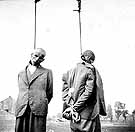
|
|
|

|

|

|

|
|
Click on an image to see a larger, more detailed picture.
|
|
|
|
|
| 1942: The "Final Solution" |

|
pg. 327 |

|
|
|
|
| |
 Jews of Kraków, Poland, were ordered to clean out the homes of their brethren, who had recently been deported from the ghetto. The first round of deportations began at the end of May 1942 and continued until June 8. During the first wave of roundups, 6000 Jews were deported to the Belzec death camp and 300 were murdered on the spot. A second Aktion took place on October 27-28; 7000 Jews were deported and 600 were killed.
Jews of Kraków, Poland, were ordered to clean out the homes of their brethren, who had recently been deported from the ghetto. The first round of deportations began at the end of May 1942 and continued until June 8. During the first wave of roundups, 6000 Jews were deported to the Belzec death camp and 300 were murdered on the spot. A second Aktion took place on October 27-28; 7000 Jews were deported and 600 were killed.
Photo: National Archives in Kraków / United States Holocaust Memorial Museum Photo Archive
|
 Appointed president of the Vichy Republic in 1942, Pierre Laval immediately became a willing tool of the Nazis. He approved and facilitated German efforts to round up and deport Jewish émigrés, including children. Laval expedited the deportation process by ordering French police to cooperate with Nazi authorities, sending some 25,000 Jews to the ghettos and concentration camps of the East during the summer months.
Appointed president of the Vichy Republic in 1942, Pierre Laval immediately became a willing tool of the Nazis. He approved and facilitated German efforts to round up and deport Jewish émigrés, including children. Laval expedited the deportation process by ordering French police to cooperate with Nazi authorities, sending some 25,000 Jews to the ghettos and concentration camps of the East during the summer months.
Photo: La Documentation Francaise / United States Holocaust Memorial Museum Photo Archive
|
 Kraków/Plaszów
Kraków/Plaszów
Home to one of the oldest and most important Jewish communities in Europe, Kraków, Poland, was transformed by the Nazis into a place of terror. The city was occupied by the Germans in September 1939 and declared the capital of the Generalgouvernement of Poland. All anti-Jewish legislation for the region was issued from Kraków. Terror campaigns against the Jews began in December 1940. Jewish property was seized, synagogues were burned, and thousands of Jews were expelled from their residences. A formal ghetto that measured 656 X 437 yards was established in March 1941. Jews from the neighboring communities were packed into the ghetto; by the end of the year, 18,000 Jews were imprisoned in Kraków. The overcrowding and deplorable sanitary conditions caused many deaths. Those pictured were hanged for railway sabotage. Deportations from Kraków to the Belzec and Auschwitz death camps began in May 1942 and continued until March 1943. On March 13, 1943, 2000 Jews were transferred to the Plaszów forced-labor camp. Located on the outskirts of Kraków, the Plaszów camp was run by the notorious Amon Goeth, a psychopathic killer who took pleasure in shooting Jews for sport from his balcony. The Kraków Ghetto and Plaszów labor camp provided the setting for the film Schindler's List.
Photo: Main Commission for the Investigation of Nazi War Crimes in Poland/United States Holocaust Memorial Museum Photo Archive
|
|

|

|

|

|
 June 3, 1942: Jews revolt in Breslau, Germany.
June 3, 1942: Jews revolt in Breslau, Germany.
|
 June 3, 1942: In Warsaw, Nazis shoot 110 Jews in a prison on Gesia Street. Ten Jewish policemen are among the victims.
June 3, 1942: In Warsaw, Nazis shoot 110 Jews in a prison on Gesia Street. Ten Jewish policemen are among the victims.
|
 June 4, 1942: Reinhard Heydrich, chief of the Reich Security Police and SD, dies of blood poisoning caused by injuries suffered in the May 27 attack by Czech partisans; See June 9, 1942.
June 4, 1942: Reinhard Heydrich, chief of the Reich Security Police and SD, dies of blood poisoning caused by injuries suffered in the May 27 attack by Czech partisans; See June 9, 1942.
|
 June 4, 1942: The U.S. declares war on Romania.
June 4, 1942: The U.S. declares war on Romania.
|
 June 5, 1942: The SS reports that 97,000 persons have been "processed" in mobile gas vans.
June 5, 1942: The SS reports that 97,000 persons have been "processed" in mobile gas vans.
|
 June 5-6, 1942: During a roundup of Jews in Kraków, Poland, SS men brutally torment two men--one who has just one leg and another who had lost his eyesight while fighting for Germany in World War I.
June 5-6, 1942: During a roundup of Jews in Kraków, Poland, SS men brutally torment two men--one who has just one leg and another who had lost his eyesight while fighting for Germany in World War I.
|
 June 6, 1942: Adolf Eichmann insists via a telegram sent to Gestapo officials that residents of a mental institution must be included in a planned mass deportation of Jews from Coblenz, Germany, to Lublin, Poland.
June 6, 1942: Adolf Eichmann insists via a telegram sent to Gestapo officials that residents of a mental institution must be included in a planned mass deportation of Jews from Coblenz, Germany, to Lublin, Poland.
|
|
|
|
|
| 1942: The "Final Solution" |

|
pg. 327 |

|
|
The Holocaust Chronicle
© 2009 Publications International, Ltd.
|
|
